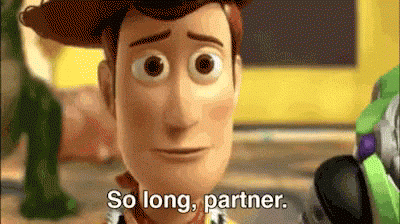I Need to Make Sure You Know This One Thing About Editors
Recently, there was yet another round of layoffs in the editing world.
While it’s just the latest event in a yearslong trend, I wanted to say something about it nonetheless.
So I dropped work on my website redesign — coming in mid-September! — to hit you with this important broadcast … slash rant.
Here it is.
The first roles media companies tend to cut in times of financial struggle include copy editors.
These companies don’t want to reduce the quantity of content they publish. Unfortunately, that often means reducing the quality instead.
Last week the Texas Tribune laid off 11 employees, including its entire copy desk. (So long, copy editors who help to make sure the news is clear and accurate!)

In June of this year, the Los Angeles Times cut 74 employees, and nearly a third came from news and copy editor ranks.
The trimming of editorial staff has been happening for years and years.
I was leading the copy desk at Time Out in 2017 when The New York Times cut its copy department, letting go of more than 100 copy editors.
The same thing is happening in the indie book world.
When times are tough, self-publishing authors can’t afford every round of editing. So they pass on a copy edit or proofread, or they combine edits.
(You all know how I feel about combo line and copy edits.)
I understand that, and I would much rather you share your stories with the world than not at all.
But I just want to make sure you know one thing:
*Copyediting and other forms of editing are important. They provide value. They provide quality assurance.*
And they do so across industries, increasing sales and readership.
Women are 81% less likely to buy a product advertised with spelling or grammar errors, and 77% of men agree.
Likewise, readers reported that poor writing, bad writing, grammar, spelling errors, mistakes, and language cause them to stop reading a book.
Copyediting upholds the integrity of journal articles, one study found.
Participants in another study “gave higher ratings to journalistic stories that had been edited than those that hadn’t.”
All of those surveys and studies show the efficacy of human editing, not AI or editing software — which is another important broadcast/rant I’ll grace you with later.
That’s all, folks.
Cheers,
Jaime
P.S. If you 100% believe in the power of editing and want me to edit your next project, don’t hesitate! Fill out this form.
Enjoy this post? Buy me a coffee in support.
Hi, I’m Jaime, editor and owner of Pristine Editing LLC. To get to know me better, and for more editing tips, sign up for my quarterly email newsletter! You can also follow me on LinkedIn and Instagram. And don’t miss out on my free style guide template.
The Simple 5-Step Process of Working with Me
Finding the right freelancer to work with can be a grueling process with a lot of unknowns. Will this person be able to deliver what I need? Is she actually an expert in copyediting and proofreading? Is she self-motivated and reliable, or will I have to check in constantly to make sure she’s meeting deadlines?
Allow me to ease your worries and doubts. My goal is not only to deliver you edits that elevate your content but also to ensure that collaborating with me is seamless. Here is what the process of working with me will look like:

Initial Contact
People interested in working with me can reach out via email (info@PristineEditing.com) or they can fill out this handy form to tell me about a project in 2 minutes flat! (Really, 2 minutes.) The second option is great for people who aren’t sure what information to share to get things started.
Once you reach out, I’ll likely get back to you within 24 business hours.
The Get-to-Know-You Call
An initial 15-minute call with me is free—and optional! Whether you seek a deeper explanation of my services, have a “weird” project and want to get a sense of whether I could help you with it, or just don’t know what you need and would like some guidance, the call is for you.
We’ll chat about your brand and your project details, and then I can tell you a little more about me and explain what services I can offer you. This is a low-pressure call — we are simply exploring whether we are a good match for collaboration.
Some people may know exactly what they want and opt to skip a call altogether, which is fine by me.
Project Confirmation
The get-to-know-you call went well! We both think we’re a good fit for each other. Now it’s time to hash out the details. I will send you a project proposal, we’ll discuss my rate, and then I will create the contract for us to sign. For one-time, flat-fee projects, I ask clients to make a 50 percent deposit.
Project Kick-Off
You will share with me all relevant documents that I need to complete the project. And then you sit back and relax, knowing that your project is in capable hands. Since we discussed details in depth, I know exactly what you want and what I agreed to deliver.
Project Completion
By the deadline we set (or even earlier!), the completed edit — which has morphed your content into a thing of beauty! — will be waiting for you in your inbox. Depending on our agreement, we may go through one or two rounds of feedback in which you review my edits, ask me questions, and then ask me to review the changes you’ve made. Then I will send you the final invoice to complete payment.
And that’s a wrap! Hopefully you will have enjoyed the process of working with me so much that we’ll become long-term partners, as so many of my current clients have.
Hi, I’m Jaime, editor and owner of Pristine Editing LLC. To get to know me better, and for more editing tips, sign up for my quarterly email newsletter! You can also follow me on LinkedIn and Instagram. And don’t miss out on my free style guide template.
Why Book Authors Should Beware Combo Line and Copy Edits

Photo by
on
When I became aware of how many editors offer combo line and copy edits, I was aghast.
Because combo line and copy edits are the worst. And I am suspicious of editors who tout them as a quality offering.
This is a controversial opinion, I know.
When I recently shared a poll in Instagram Stories (pristine.editing.services) asking editors and authors whether they liked combo line and copy edits, 75 percent said yes! Many editors with decades of publishing experience offer them.
However, in my experience, a combo line and copy edit is bad for both the author and the editor. And there are editors who agree with me. Just check out the comments of my Instagram post.
I completed a few combo line and copy edits when I worked for a book-editing service provider about two years ago. I’ll never do another.
To the editors who say that line editing and copyediting complement each other well because they are both sentence-level editing, I say:
https://media.giphy.com/media/1BdtqhrkXU59XURZNN/giphy.gif
The goals, rules, and style of the two types of editing could not be more different. Calling them both sentence-level editing is about as misleading as saying your life coach is in the same field as your heart surgeon because they both care for your well-being.
Line editing is still in the realm of developmental or structural editing. Copyediting happens after the developmental or structural editing is over — it’s part of the process of preparing the manuscript for publication. Major changes can be made in line editing. They should definitely not be made in copyediting.
Line editing is interpretive. Line editors are free to change whatever they want in the name of smooth flow and lyricism.
Copyediting is technical. Expert copy editors will only change what is necessary for correct grammar, punctuation, spelling, syntax, repetition, and style. Otherwise, they don’t touch a word—even if they personally don’t like how something is phrased.
Line editing and copyediting are separate processes for a reason.
https://media.giphy.com/media/h5ozMZZrfMJR1Do4aK/giphy.gif
The books for which I did a combo line and copy edit needed a lot of work.
I rewrote a significant amount and left a lot of comments for the writer — which is totally okay! That’s what developmental editing is for.
What wasn’t okay was that I was expected to turn a messy manuscript into a nearly publication-ready document. That’s problematic because:
It sets unrealistic expectations and is a ton of work for the editor. Because the editor is trying to accomplish so much, a combo line and copy edit isn’t going to be as effective as separate line and copy edits. And that, of course, hurts authors.
The amount of work involved is one reason I doubt an expert editor would want to offer a combo line and copy edit. It makes me question the quality of the edit being offered. You get what you pay for.
Some of those who answered my Instagram poll said they like the combo edit because it seems natural to fix errors while line editing. That’s true! A good line editor should leave the document as clean as possible. But that’s not the editor’s № 1 priority in a line edit. And catching errors does not equate to a thorough copy edit.
As a line editor concentrates on fluid prose and improving a scene, is she also going to catch that one character’s eyes are brown on page 12 and hazel on page 132? Or that sneakily incorrect subject-verb agreement that most people would miss on a first pass? Or that non sequitur that wasn’t immediately obvious but, upon further consideration, doesn’t make sense? Or that the author wrote free reign when she meant to write free rein? Or that the character lost her keys on Wednesday, but on Friday, she says she lost her keys three days ago?
“But wouldn’t comments about timeline issues, etc., fall into the category of line editing?” asked one of my shrewd Instagram followers.
To me, weeding out lingering small plot gaps, timeline mismatches, and other hiccups is part of ensuring consistency—a golden rule of copyediting.
Perhaps addressing those issues does goes a little above and beyond a standard copy edit. That’s why I offer authors a copyediting package with margin commentary for pointing out those remaining low-level developmental concerns. The copyediting stage is an excellent time to do that because it’s the first close review of the story post-developmental editing. (Which is yet another reason the copy edit should be separate from the line edit or any other form of developmental editing.)
Line editors do deal with much larger fixes of plot gaps, timelines issues, and more. But because they’re so focused on those bigger issues and ensuring fluid prose, they just might miss the smaller stuff.
I understand that the combo line and copy edit is more tempting for independent authors financially. My guess is that editors offer the combo line and copy edit solely because it is so attractive to authors with tight budgets. And I am all for making publishing more accessible to everyone.
If a combo line and copy edit is the only way an author can afford line editing and copyediting, then do it, absolutely. It’s better than nothing.
But it seems there’s a widespread misconception that the combo line and copy edit is just as viable as separate line and copy edits. It’s not.
Also, it’s important to note that the combo line and copy edit is not necessarily cost-effective.
What happens if the line edits inspire the author to rewrite sections of the book? That happened in every combo line and copy edit I completed. The author then has to start (and pay for) at least the copyediting process all over again.
I’m sure there are exceptions to this strong opinion of mine. Perhaps there’s a reason editors offer combo line and copy edits that I just can’t see or haven’t heard.
Even as I write this post, three editors have voted that, yes, they do offer combo line and copy edits on my Twitter poll.
I welcome having my eyes opened on the subject. Comment below or send me an email at info@pristineediting.com.
Hi, I’m Jaime, editor and owner of Pristine Editing LLC. To get to know me better, and for more editing tips, sign up for my quarterly email newsletter! You can also follow me on LinkedIn and Instagram. And don’t miss out on my free style guide template.